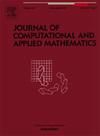一种有效的一阶条件梯度算法在数据驱动的非线性动力学稀疏识别中解决噪声下的稀疏恢复问题
IF 2.1
2区 数学
Q1 MATHEMATICS, APPLIED
Journal of Computational and Applied Mathematics
Pub Date : 2025-04-15
DOI:10.1016/j.cam.2025.116675
引用次数: 0
摘要
控制方程对于非线性动力学的研究至关重要,通常可以预测以前看不见的行为,并将其包含在控制策略中。因此,从数据中发现控制方程有可能改变数据丰富的领域,在这些领域中,完善的动态模型仍然是未知的。这项工作有助于数据驱动的非线性动力学稀疏识别的最新趋势,即在大量潜在非线性模型库中找到观测数据的最佳稀疏拟合。我们提出一种有效的一阶条件梯度算法来解决潜在的优化问题。与最突出的替代框架相比,新框架在稀疏性诱导、结构保存、噪声鲁棒性和样本效率等几个基本问题上表现出显着改善的性能。我们从同步、粒子动力学和酶化学领域的几个动力学方面证明了这些优势。本文章由计算机程序翻译,如有差异,请以英文原文为准。
An efficient first-order conditional gradient algorithm in data-driven sparse identification of nonlinear dynamics to solve sparse recovery problems under noise
Governing equations are essential to the study of nonlinear dynamics, often enabling the prediction of previously unseen behaviors as well as the inclusion into control strategies. The discovery of governing equations from data thus has the potential to transform data-rich fields where well-established dynamical models remain unknown. This work contributes to the recent trend in data-driven sparse identification of nonlinear dynamics of finding the best sparse fit to observational data in a large library of potential nonlinear models. We propose an efficient first-order Conditional Gradient algorithm for solving the underlying optimization problem. In comparison to the most prominent alternative framework, the new framework shows significantly improved performance on several essential issues like sparsity-induction, structure-preservation, noise robustness, and sample efficiency. We demonstrate these advantages on several dynamics from the field of synchronization, particle dynamics, and enzyme chemistry.
求助全文
通过发布文献求助,成功后即可免费获取论文全文。
去求助
来源期刊
CiteScore
5.40
自引率
4.20%
发文量
437
审稿时长
3.0 months
期刊介绍:
The Journal of Computational and Applied Mathematics publishes original papers of high scientific value in all areas of computational and applied mathematics. The main interest of the Journal is in papers that describe and analyze new computational techniques for solving scientific or engineering problems. Also the improved analysis, including the effectiveness and applicability, of existing methods and algorithms is of importance. The computational efficiency (e.g. the convergence, stability, accuracy, ...) should be proved and illustrated by nontrivial numerical examples. Papers describing only variants of existing methods, without adding significant new computational properties are not of interest.
The audience consists of: applied mathematicians, numerical analysts, computational scientists and engineers.

 求助内容:
求助内容: 应助结果提醒方式:
应助结果提醒方式:


